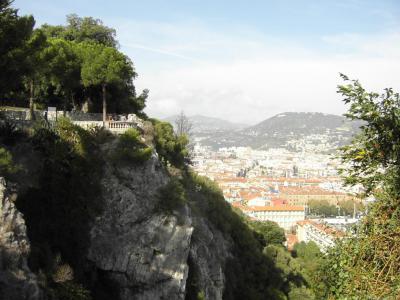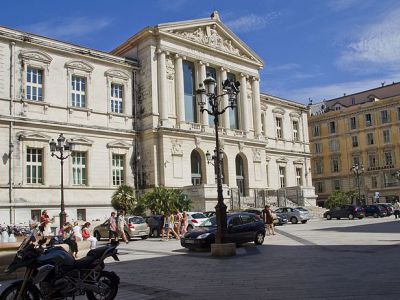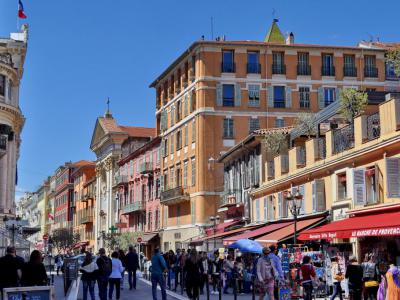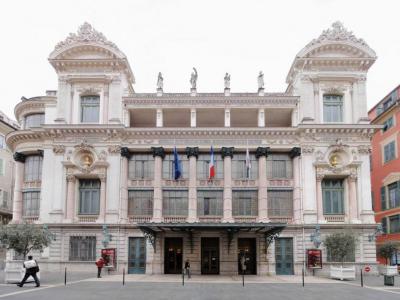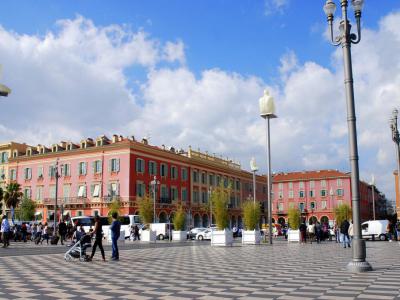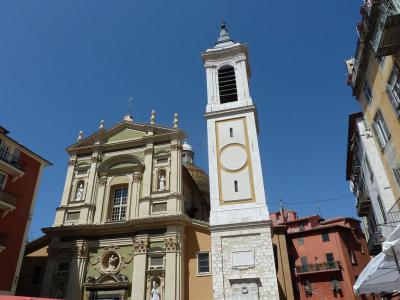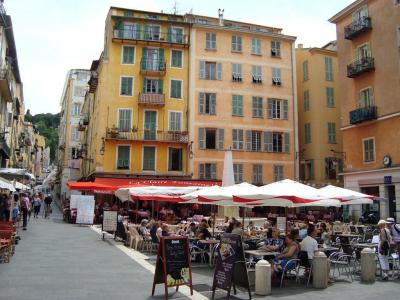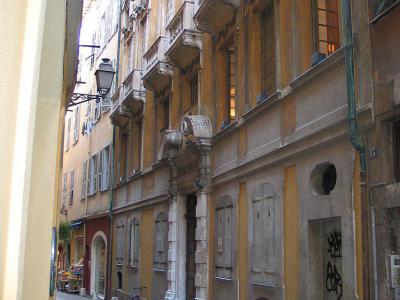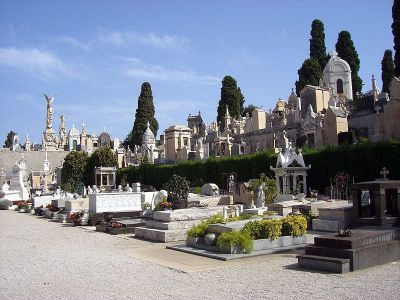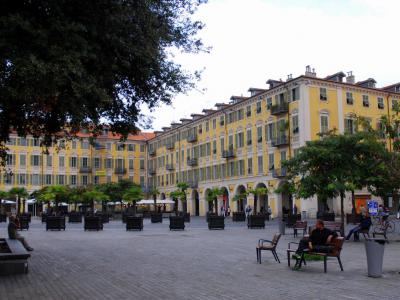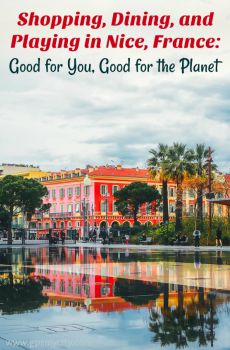
Nice Introduction Walking Tour (Self Guided), Nice
Nice – an iconic destination sprawled along the pebbly shore of the Baie des Anges in Southern France – has been the lure for the rich and famous for centuries, thanks to its temperate Mediterranean climate and picturesque seafront.
Founded by the Greeks of Marseille around 350 BC as a permanent settlement called Nikaia, after Nike – the goddess of victory, the town has changed hands many times throughout its history. In large part, this was due to a strategic location and significance as a seaport. For ages, Nice had been a dominion of Savoy, then part of France – between 1792 and 1815, when it was returned to the Kingdom of Piedmont-Sardinia until its re-annexation by France in 1860.
In the 19th century the city became a retreat for European elite, such as royals like British Queen Victoria and her son Edward VII, Prince Nicholas Alexandrovich – heir apparent to Imperial Russia, and Princess Catherine Dolgorukova – morganatic wife of the Russian Tsar Alexander II; and prominent art figures like Henri Matisse, Marc Chagall, Friedrich Nietzsche, and Anton Chekhov.
It is probably through this association, and deservedly so, that the city has earned the nickname Nice la Belle, which means “Nice the Beautiful”, and is also the title of its unofficial anthem. In 2021 the city was declared a World Heritage Site by UNESCO as "Nice, Winter Resort Town of the Riviera".
Other than chic boutiques, hotels and restaurants, the place is famed primarily for its numerous historic attractions, namely:
Promenade des Anglais (English Promenade) – emerged in the second half of the 18th century courtesy of the early aristocratic English colony who conceived building of a promenade; first called Camin dei Anglès (the English Way), it was later rechristened, in 1823, La Promenade des Anglais.
Nice Opera House – the principal opera venue in Nice, constructed at the end of the 19th century; also houses the Ballet Nice Méditerrannée and the Nice Philharmonic Orchestra.
Cours Saleya Markets – probably the most traditional square in town, home to the daily market selling fresh flowers, antiques, as well as local produce & food products.
Massena Square – the main square of the city, traditional spot for public gatherings: concerts, festivals, national celebrations and banquets.
To find your way around and to learn more about these and other top landmarks of Nice, follow our introductory walk!
Founded by the Greeks of Marseille around 350 BC as a permanent settlement called Nikaia, after Nike – the goddess of victory, the town has changed hands many times throughout its history. In large part, this was due to a strategic location and significance as a seaport. For ages, Nice had been a dominion of Savoy, then part of France – between 1792 and 1815, when it was returned to the Kingdom of Piedmont-Sardinia until its re-annexation by France in 1860.
In the 19th century the city became a retreat for European elite, such as royals like British Queen Victoria and her son Edward VII, Prince Nicholas Alexandrovich – heir apparent to Imperial Russia, and Princess Catherine Dolgorukova – morganatic wife of the Russian Tsar Alexander II; and prominent art figures like Henri Matisse, Marc Chagall, Friedrich Nietzsche, and Anton Chekhov.
It is probably through this association, and deservedly so, that the city has earned the nickname Nice la Belle, which means “Nice the Beautiful”, and is also the title of its unofficial anthem. In 2021 the city was declared a World Heritage Site by UNESCO as "Nice, Winter Resort Town of the Riviera".
Other than chic boutiques, hotels and restaurants, the place is famed primarily for its numerous historic attractions, namely:
Promenade des Anglais (English Promenade) – emerged in the second half of the 18th century courtesy of the early aristocratic English colony who conceived building of a promenade; first called Camin dei Anglès (the English Way), it was later rechristened, in 1823, La Promenade des Anglais.
Nice Opera House – the principal opera venue in Nice, constructed at the end of the 19th century; also houses the Ballet Nice Méditerrannée and the Nice Philharmonic Orchestra.
Cours Saleya Markets – probably the most traditional square in town, home to the daily market selling fresh flowers, antiques, as well as local produce & food products.
Massena Square – the main square of the city, traditional spot for public gatherings: concerts, festivals, national celebrations and banquets.
To find your way around and to learn more about these and other top landmarks of Nice, follow our introductory walk!
How it works: Download the app "GPSmyCity: Walks in 1K+ Cities" from Apple App Store or Google Play Store to your mobile phone or tablet. The app turns your mobile device into a personal tour guide and its built-in GPS navigation functions guide you from one tour stop to next. The app works offline, so no data plan is needed when traveling abroad.
Nice Introduction Walking Tour Map
Guide Name: Nice Introduction Walking Tour
Guide Location: France » Nice (See other walking tours in Nice)
Guide Type: Self-guided Walking Tour (Sightseeing)
# of Attractions: 11
Tour Duration: 2 Hour(s)
Travel Distance: 2.9 Km or 1.8 Miles
Author: karen
Sight(s) Featured in This Guide:
Guide Location: France » Nice (See other walking tours in Nice)
Guide Type: Self-guided Walking Tour (Sightseeing)
# of Attractions: 11
Tour Duration: 2 Hour(s)
Travel Distance: 2.9 Km or 1.8 Miles
Author: karen
Sight(s) Featured in This Guide:
- Colline du Chateau (Castle Hill)
- Place du Palais de Justice (Courthouse Square)
- Cours Saleya Markets
- Opera de Nice (Nice Opera House)
- Promenade des Anglais (English Promenade)
- Place Massena (Massena Square)
- Cathédrale Sainte-Réparate (Saint Reparate Cathedral)
- Place Rossetti (Rossetti Square)
- Palais Lascaris (Lascaris Palace)
- Cimetiere du Chateau (Chateau Cemetery)
- Place Garibaldi (Garibaldi Square)
1) Colline du Chateau (Castle Hill) (must see)
Colline du Château or Castle Hill is a must see while in Nice with its breathtaking views of the city and the Mediterranean Sea. This area is where Nice was founded in the third century BCE. From high on the hill a trading post was established and then a defensive post was maintained. A large wall was built around the city only to be torn down in the early 1700s.
Don’t go to the hill expecting to see the “Castle”, as a few ruins still remain but that is all. The area is still intriguing nonetheless. Aside from the exquisite views, there is a beautiful park, the Naval Museum, stepping stones that depict the Odyssey by Homer and a beautiful old cemetery filled with gorgeous headstones.
There is also a man-made waterfall along the way. This sometimes gets shutoff in the late afternoon, so be sure to visit early if you want to see it. There are plenty of benches around the area so take a few minutes to revel in the Mediterranean splendor of the park. This is a great place to pack a picnic lunch and spend the afternoon. There is a small cafe in the area too.
Getting to the hill can be accomplished several different ways depending upon time constraints and fitness. For those who like to walk, take the steps up to the observation platform. There are 213 steps but the view is spectacular along the way. For a fee, there is also an elevator or a motorized train. The train does not really allow for any wandering, so for those who like to stroll and look on their own schedule, take the steps or the elevator or a combination of the two.
Don't forget the camera and a little extra cash for a snack. Plan on spending at least a couple of hours here. The area opens daily at 8 AM but the closing times vary with the seasons, so be sure to go earlier in the day. Keep in mind that some shops in the area will be closed from 12-2PM for lunch, so plan accordingly.
Don’t go to the hill expecting to see the “Castle”, as a few ruins still remain but that is all. The area is still intriguing nonetheless. Aside from the exquisite views, there is a beautiful park, the Naval Museum, stepping stones that depict the Odyssey by Homer and a beautiful old cemetery filled with gorgeous headstones.
There is also a man-made waterfall along the way. This sometimes gets shutoff in the late afternoon, so be sure to visit early if you want to see it. There are plenty of benches around the area so take a few minutes to revel in the Mediterranean splendor of the park. This is a great place to pack a picnic lunch and spend the afternoon. There is a small cafe in the area too.
Getting to the hill can be accomplished several different ways depending upon time constraints and fitness. For those who like to walk, take the steps up to the observation platform. There are 213 steps but the view is spectacular along the way. For a fee, there is also an elevator or a motorized train. The train does not really allow for any wandering, so for those who like to stroll and look on their own schedule, take the steps or the elevator or a combination of the two.
Don't forget the camera and a little extra cash for a snack. Plan on spending at least a couple of hours here. The area opens daily at 8 AM but the closing times vary with the seasons, so be sure to go earlier in the day. Keep in mind that some shops in the area will be closed from 12-2PM for lunch, so plan accordingly.
2) Place du Palais de Justice (Courthouse Square)
Courthouse Square has recently received a well-deserved facelift. The whole area has been given a bit of a polish and shine, making it a delightful and picturesque neighborhood.
The fountain in front of the courthouse is absolutely gorgeous. The steps leading into the building lend themselves to getting an elevated picture of the surrounding area. They are also a great place to gather a large travel group to snap a shot with a nice backdrop of the Neo-Classical Palace.
While the building itself is very impressive, it is really the outside area that makes it worth visiting. The colorful pavement and cafés create a lovely ambiance, not to mention the street vendors who also add a nice touch and may have exactly what you need to fill that little void in your suitcase for a souvenir.
In the Place du Palais de Justice market you can spend hours browsing through vendor wares in the open air. There is something new to rifle through every week. The 1st and 3rd Saturdays of the month are for second-hand books, old posters and antiques; the 2nd Saturday is all about local arts and crafts, while the last Saturday of the month is dedicated to vintage postcards and magazines.
Why You Should Visit:
Another one of Nice's finest squares, with plenty of activity both day and night!
The fountain in front of the courthouse is absolutely gorgeous. The steps leading into the building lend themselves to getting an elevated picture of the surrounding area. They are also a great place to gather a large travel group to snap a shot with a nice backdrop of the Neo-Classical Palace.
While the building itself is very impressive, it is really the outside area that makes it worth visiting. The colorful pavement and cafés create a lovely ambiance, not to mention the street vendors who also add a nice touch and may have exactly what you need to fill that little void in your suitcase for a souvenir.
In the Place du Palais de Justice market you can spend hours browsing through vendor wares in the open air. There is something new to rifle through every week. The 1st and 3rd Saturdays of the month are for second-hand books, old posters and antiques; the 2nd Saturday is all about local arts and crafts, while the last Saturday of the month is dedicated to vintage postcards and magazines.
Why You Should Visit:
Another one of Nice's finest squares, with plenty of activity both day and night!
3) Cours Saleya Markets (must see)
A trip to Nice absolutely must include a stroll around the Cours Saleya. This incredible area used to be the city square in the days gone by. It is now an open-air market that has many different vendors available throughout the week. The sights, sounds, smells and the people are sure to be one of the highlights of any trip.
Every Monday morning there is an antique market, where the perfect bit of Art Deco or that one unique souvenir may be purchased. If you love antiques, do not miss coming on Mondays. Tuesday through Sunday, the market is devoted to fresh, colorful flowers and fruits of all kinds. Of course, it really depends upon the time of year one visits as to what produce will be available, but whatever is being sold, it will be fresh.
Be sure to arrive early at the market; the stalls open at 6 am, so try to get there as soon as possible after that. For early birds, this place is a real treat. Reusable bags to carry home purchases are absolutely necessary as well as plenty of small bills and change. The vendors will have enough customers that they don’t need to worry about fussing with making huge amounts of change for one customer.
For those who have cooking facilities where they are staying, do not miss the fresh fish market. There is no comparison of taste in fish that went from the water to the table in just a few hours. What a delight, especially when accompanied by fresh herbs, bread, veggies and paired with an incredible wine.
During the summertime, the Cours Saleya turns into a craft market on the warm evenings. It is possible to go to the market in the morning to pick up fresh flowers, a bit of fruit, cheese, olives and bread for the day and then return in the evening to buy some delightful craft product to remember the trip by. The area is also home to several cafes and restaurants. What a way to spend a summer day in Nice!
Tip:
Be there around noon – that's when they fire a cannon after an old habit of the Duke of Nizza that tried to get his shop-a-holic wife home for lunch this way.
Every Monday morning there is an antique market, where the perfect bit of Art Deco or that one unique souvenir may be purchased. If you love antiques, do not miss coming on Mondays. Tuesday through Sunday, the market is devoted to fresh, colorful flowers and fruits of all kinds. Of course, it really depends upon the time of year one visits as to what produce will be available, but whatever is being sold, it will be fresh.
Be sure to arrive early at the market; the stalls open at 6 am, so try to get there as soon as possible after that. For early birds, this place is a real treat. Reusable bags to carry home purchases are absolutely necessary as well as plenty of small bills and change. The vendors will have enough customers that they don’t need to worry about fussing with making huge amounts of change for one customer.
For those who have cooking facilities where they are staying, do not miss the fresh fish market. There is no comparison of taste in fish that went from the water to the table in just a few hours. What a delight, especially when accompanied by fresh herbs, bread, veggies and paired with an incredible wine.
During the summertime, the Cours Saleya turns into a craft market on the warm evenings. It is possible to go to the market in the morning to pick up fresh flowers, a bit of fruit, cheese, olives and bread for the day and then return in the evening to buy some delightful craft product to remember the trip by. The area is also home to several cafes and restaurants. What a way to spend a summer day in Nice!
Tip:
Be there around noon – that's when they fire a cannon after an old habit of the Duke of Nizza that tried to get his shop-a-holic wife home for lunch this way.
4) Opera de Nice (Nice Opera House)
On a fine day in Nice summer strollers may have their serenity interrupted by cannon shot. This is the customary "mark the midday" cannon shot. It is also a cue for a semi-impromptu performance of live music in the forecourt of the Nice Opera House. As the echos of artillery fade from Castle Hill, a free mini half-hour concert restores the peace.
Nice Opera House is the esteemed venue for opera in Nice. Housed in a massive Baroque Revival edifice, it normally offers three kinds of entertainment besides the midday jam. Operas, ballets and classical music have graced its stages since 1776. Then it was called "made of wood".
Nice Opera House has had several incarnations since 1776. It was demolished and rebuilt (not using wood) by the City of Nice in 1828 and named "Theatre Municipal" in 1870. All went well until 1881. Then, during a performance of Lucia di Lammermoor, there was a gas explosion and it burned to the ground. The City chose to rebuild.
The Baroque Revival home of today was designed by Francois Aune. It resembles closely the Paris Opera House by Charles Garnier. The theatre may seem huge but it maintains an air of comfort and intimacy. It holds three levels of boxes and two more of galleries. Its congenial, welcoming atmosphere and dedicated tour guides promise a happy evening.
Nice Opera House is the esteemed venue for opera in Nice. Housed in a massive Baroque Revival edifice, it normally offers three kinds of entertainment besides the midday jam. Operas, ballets and classical music have graced its stages since 1776. Then it was called "made of wood".
Nice Opera House has had several incarnations since 1776. It was demolished and rebuilt (not using wood) by the City of Nice in 1828 and named "Theatre Municipal" in 1870. All went well until 1881. Then, during a performance of Lucia di Lammermoor, there was a gas explosion and it burned to the ground. The City chose to rebuild.
The Baroque Revival home of today was designed by Francois Aune. It resembles closely the Paris Opera House by Charles Garnier. The theatre may seem huge but it maintains an air of comfort and intimacy. It holds three levels of boxes and two more of galleries. Its congenial, welcoming atmosphere and dedicated tour guides promise a happy evening.
5) Promenade des Anglais (English Promenade) (must see)
In the late 1700s English aristocracy took a fancy to the City of Nice. They would spend their winters on the shore. In 1820 the winter was very harsh and the English tourists found themselves inundated by a wave of beggars. What to do? The city would build a walkway along the seashore, and the Anglican Church would pay for it. Brilliant idea!
The city fathers went beyond themselves and greatly expanded the range of the project. The City was annexed by France in 1860 and the Chemin de Promenade became La Promenade des Anglais. Today, local people call it "La Prom." it is popular with walkers, families, skateboarders and cyclists. The team trial of the 2013 Tour de France was held there.
The Promenade extends for four miles around the Baie des Anges. On the seaward side there are private and public beaches shoulder to shoulder. The beaches are mobbed in the summer. Try not to mind if you have to share a spot. In the hills above Nice are aristocratic houses converted to grand hotels and museums.
Tip:
Try and avoid eating at restaurants on the front – food is nice but more expensive. The more traditional restaurants frequented by locals are a little bit further off the promenade. One of the most interesting and lively parts is between the Boulevard Gambetta and the Vieux Ville. There you'll find most of the big Belle Époque hotels and fancy residence and plenty more to see.
The city fathers went beyond themselves and greatly expanded the range of the project. The City was annexed by France in 1860 and the Chemin de Promenade became La Promenade des Anglais. Today, local people call it "La Prom." it is popular with walkers, families, skateboarders and cyclists. The team trial of the 2013 Tour de France was held there.
The Promenade extends for four miles around the Baie des Anges. On the seaward side there are private and public beaches shoulder to shoulder. The beaches are mobbed in the summer. Try not to mind if you have to share a spot. In the hills above Nice are aristocratic houses converted to grand hotels and museums.
Tip:
Try and avoid eating at restaurants on the front – food is nice but more expensive. The more traditional restaurants frequented by locals are a little bit further off the promenade. One of the most interesting and lively parts is between the Boulevard Gambetta and the Vieux Ville. There you'll find most of the big Belle Époque hotels and fancy residence and plenty more to see.
6) Place Massena (Massena Square) (must see)
Andre Messena was a boy from Nice who became a Marshal of France. Messena Square in Nice is named for him. The square was designed by Joseph Vernier in 1844. It is spacious and bordered by ochre-colored Italianate buildings, palm trees and stone pines. It is but a short walk from the English Promenade and the Albert I Garden.
Massena Square is a popular place for concerts, public events and festivals. The Carnival Parade, Bastille Day, and other traditional observances are held in the square. One feature of the square is the Open Sky Museum. Seven Buddhist figures sit on stilts high above the square. At night they light up in different colors.
The Open Sky Museum also has a display of blue green "fairy" lights in a form of poetic Morse code. Opposite the lights is the sculpture Neufs Lignes Obliques, nine diagonal lines created for the 150th anniversary of Nice as a French city. Meanwhile, in the Sun Fountain, the god Apollo is in full monte watching over the city watching him.
The Promenade de Paillon is a luscious green park on the side of the square. The park has shrubs and palm trees and the Mirror Fountain. The base of the mirror is polished stone that shines like a mirror when wet. To provide this effect, thin jets of water spurt up at evenly spaced points. Children (and adults) run joyfully through the mists.
Facing the Promenade de Paillon is the Albert I Garden. A public park created in the 1880s, the Albert I Garden extends from Massena Square, connecting the English Promenade to Nice Old Town. The park is the venue for festivals in the summer, especially the Nice Jazz Festival. It has fountains and exotic flowers; a calm green area in the day.
Why You Should Visit:
The square is the heart of Nice. Spacious and busy but never oppressively crowded, it offers something for each generation.
Massena Square is a popular place for concerts, public events and festivals. The Carnival Parade, Bastille Day, and other traditional observances are held in the square. One feature of the square is the Open Sky Museum. Seven Buddhist figures sit on stilts high above the square. At night they light up in different colors.
The Open Sky Museum also has a display of blue green "fairy" lights in a form of poetic Morse code. Opposite the lights is the sculpture Neufs Lignes Obliques, nine diagonal lines created for the 150th anniversary of Nice as a French city. Meanwhile, in the Sun Fountain, the god Apollo is in full monte watching over the city watching him.
The Promenade de Paillon is a luscious green park on the side of the square. The park has shrubs and palm trees and the Mirror Fountain. The base of the mirror is polished stone that shines like a mirror when wet. To provide this effect, thin jets of water spurt up at evenly spaced points. Children (and adults) run joyfully through the mists.
Facing the Promenade de Paillon is the Albert I Garden. A public park created in the 1880s, the Albert I Garden extends from Massena Square, connecting the English Promenade to Nice Old Town. The park is the venue for festivals in the summer, especially the Nice Jazz Festival. It has fountains and exotic flowers; a calm green area in the day.
Why You Should Visit:
The square is the heart of Nice. Spacious and busy but never oppressively crowded, it offers something for each generation.
7) Cathédrale Sainte-Réparate (Saint Reparate Cathedral) (must see)
The Saint Reparate Cathedral is one of the most interesting and beautiful cathedrals in Nice. It sits on the site of a small church called Saint Mary of the Castle that dates back circa 1049. The current structure was built in the middle 17th century, and dedicated in 1699. The building is magnificent and contains 10 chapels maintained by private families, and three organs.
The name comes from a young Palestinian boy who was martyred for his Christian faith. Saint Reparate was 15 when he was beheaded and his body set adrift in a small vessel. According to legend, the boat floated up to the shores of Nice and he is now buried at the cathedral.
There have been additions over the years; the Baroque facade was added in the early 1800s. This hides the original cupola which is still there, but a bit hard to see. However, the cupola is covered in colored tiles and is beautiful standing guard over the transept.
The inside also carries on the Baroque theme with plentiful use of marble and gold. The barrel ceilings only add to the huge splendor of the cathedral which is built in the style of the Latin cross. This is definitely a must see when in Nice.
The name comes from a young Palestinian boy who was martyred for his Christian faith. Saint Reparate was 15 when he was beheaded and his body set adrift in a small vessel. According to legend, the boat floated up to the shores of Nice and he is now buried at the cathedral.
There have been additions over the years; the Baroque facade was added in the early 1800s. This hides the original cupola which is still there, but a bit hard to see. However, the cupola is covered in colored tiles and is beautiful standing guard over the transept.
The inside also carries on the Baroque theme with plentiful use of marble and gold. The barrel ceilings only add to the huge splendor of the cathedral which is built in the style of the Latin cross. This is definitely a must see when in Nice.
8) Place Rossetti (Rossetti Square)
If you need a place to go for a day to just sit back and watch the world go by in Nice, you may want to visit the famous Rossetti Square. This public square is reachable by several of the old streets that wander through this part of town. It has a beautiful fountain at the heart of the location, done in a classic Italian Baroque style.
The square is located in the center of the part of town known as the Old Nice. The surrounding buildings are very old, and almost appear as though they are leaning far enough to fall over. Please also watch out for the laundry hanging overhead. While in the area, you may want to visit the Saint Réparate Cathedral or get yourself some ice cream at Fenocchio’s. The church is one of the best examples of Baroque architecture in town while the ice cream is very popular among tourists and locals alike. You will also want to plan on having lunch or dinner in one of the fine restaurants or cafes located around the square. Bon Appétit.
The square is located in the center of the part of town known as the Old Nice. The surrounding buildings are very old, and almost appear as though they are leaning far enough to fall over. Please also watch out for the laundry hanging overhead. While in the area, you may want to visit the Saint Réparate Cathedral or get yourself some ice cream at Fenocchio’s. The church is one of the best examples of Baroque architecture in town while the ice cream is very popular among tourists and locals alike. You will also want to plan on having lunch or dinner in one of the fine restaurants or cafes located around the square. Bon Appétit.
9) Palais Lascaris (Lascaris Palace)
Lascaris Palace was built in the 1600s for the Lascaris-Vintimille family. It is one of the best representations of how the truly wealthy lived during that time period. The palace was restored during the 1940s and then was open to the public as a museum. The spectacular Baroque building is well worth the visit for anyone, but an absolute must-see for those who love musical instruments.
Le Groupe AXA loaned an extensive collection of period instruments to the museum. In addition, there are also paintings that depict musical instruments, and it is not unusual to be able to hear some of the instruments being played. The palace also hosts several musical events throughout the year – check the schedule.
Be sure to see the "noble floor", where much of the original grandeur has been restored. This was used as a gathering place and is very fitting for a rich, noble family. The palace has the obligatory Baroque staircase as well as beautiful murals and tapestries. There is also an apothecary on the ground floor that houses many original pieces from the 18th century and some beautiful delft pieces.
Tip:
Remember that you can get a combined city museum ticket for €10 valid 24 hours or a week-long ticket for €20 allowing access to all Nice museums. It saves you money!
Le Groupe AXA loaned an extensive collection of period instruments to the museum. In addition, there are also paintings that depict musical instruments, and it is not unusual to be able to hear some of the instruments being played. The palace also hosts several musical events throughout the year – check the schedule.
Be sure to see the "noble floor", where much of the original grandeur has been restored. This was used as a gathering place and is very fitting for a rich, noble family. The palace has the obligatory Baroque staircase as well as beautiful murals and tapestries. There is also an apothecary on the ground floor that houses many original pieces from the 18th century and some beautiful delft pieces.
Tip:
Remember that you can get a combined city museum ticket for €10 valid 24 hours or a week-long ticket for €20 allowing access to all Nice museums. It saves you money!
10) Cimetiere du Chateau (Chateau Cemetery)
Being a cemetery does not make it a less interesting place to visit. Chateau Cemetery sits on top of the hill at Cimiez, and has one of the most beautiful views of the city. So, visiting the cemetery is certainly not very depressing.
The cemetery was founded in 1783. Most of the graves are very ornate and there are many small chapel style gravesites made in white marble. The works of art kind of reflect the love of art that the locals have for all aspects of life. Here art is life.
Most people visit this place, though, for two famous people who are buried here. It is the final resting place of Raoul Dufy, the famous French Fauvist painter. This is also the burial spot for the internationally renowned French painter Henri Matisse, whose works are adored by millions of art lovers worldwide. You will have to look a bit for the burying site of Dufy, as it is a very simple plot to say the least. It located near the Monastery garden gate. Matisse’s grave, on the other hand, is easier to spot.
The Chateau Cemetery used to also be the citadel for the city in the 16th Century. There are, in toto, more than 2800 people buried here. Besides the two people already mentioned, you can find the final resting places of other famous people like Gaston Leroux, a French journalist and author of detective fiction, and Emil Jellinek-Mercedes, an entrepreneur and industrialist who commissioned the first modern automobile, the Mercedes 35 HP.
The cemetery was founded in 1783. Most of the graves are very ornate and there are many small chapel style gravesites made in white marble. The works of art kind of reflect the love of art that the locals have for all aspects of life. Here art is life.
Most people visit this place, though, for two famous people who are buried here. It is the final resting place of Raoul Dufy, the famous French Fauvist painter. This is also the burial spot for the internationally renowned French painter Henri Matisse, whose works are adored by millions of art lovers worldwide. You will have to look a bit for the burying site of Dufy, as it is a very simple plot to say the least. It located near the Monastery garden gate. Matisse’s grave, on the other hand, is easier to spot.
The Chateau Cemetery used to also be the citadel for the city in the 16th Century. There are, in toto, more than 2800 people buried here. Besides the two people already mentioned, you can find the final resting places of other famous people like Gaston Leroux, a French journalist and author of detective fiction, and Emil Jellinek-Mercedes, an entrepreneur and industrialist who commissioned the first modern automobile, the Mercedes 35 HP.
11) Place Garibaldi (Garibaldi Square) (must see)
Garibaldi Square is in the northern part of the district of Nice Old Town. Designed by Antoine Spinelli, it was built in 1773. It is among the oldest squares in the city. Garibaldi Square is a rectangle 403 feet long and 302 feet wide. Near the middle of the square is the Garibaldi monument. Garibaldi stands on a pedestal decked with escutcheons and lions.
The square is transfixed by Jean Jaures Boulevard, Republic Avenue, rue Cassini Street and Catherine Segurane Street. Around the square are baroque buildings with arcades. Most of the buildings are of three stories with yellow or orange brick facades. Also in the square are the Chapel of the Holy Sepulcher, the Cafe de Turin and the National Theatre.
In the southern part of the square there may be found the remains of the city at different periods of its history, especially the old fortifications. A crypt can be seen under the square and the northerly part of Boulevard Jean Jaures. There are parts of the Pairoliere Tower, the bastion of Saint-Sebastien and the faubourg des Augustins.
The square is transfixed by Jean Jaures Boulevard, Republic Avenue, rue Cassini Street and Catherine Segurane Street. Around the square are baroque buildings with arcades. Most of the buildings are of three stories with yellow or orange brick facades. Also in the square are the Chapel of the Holy Sepulcher, the Cafe de Turin and the National Theatre.
In the southern part of the square there may be found the remains of the city at different periods of its history, especially the old fortifications. A crypt can be seen under the square and the northerly part of Boulevard Jean Jaures. There are parts of the Pairoliere Tower, the bastion of Saint-Sebastien and the faubourg des Augustins.
Walking Tours in Nice, France
Create Your Own Walk in Nice
Creating your own self-guided walk in Nice is easy and fun. Choose the city attractions that you want to see and a walk route map will be created just for you. You can even set your hotel as the start point of the walk.
Shopping Areas in Nice
Other than being just a fashionable French Riviera destination with lively streets, leisurely atmosphere, historical sites and beautiful architecture, Nice is also a true shopper’s paradise. With more than 7,000 shopping options scattered throughout its almost 72 sq km area, the city surely knows how to offer unique and varied goods to its trendy residents and similarly stylish travelers anxious... view more
Tour Duration: 1 Hour(s)
Travel Distance: 1.3 Km or 0.8 Miles
Tour Duration: 1 Hour(s)
Travel Distance: 1.3 Km or 0.8 Miles
Historical Churches Walking Tour
Centuries of somewhat turbulent history have left imprint on the face of Old Nice, which until the 18th century represented the entire urban area. The abundance of historic and often colorful churches – about nine per square mile – ranging from the most opulent to the most obscure, each with its own quirks and story behind their stained glass, has made Old Nice part of a heritage preservation... view more
Tour Duration: 2 Hour(s)
Travel Distance: 3.4 Km or 2.1 Miles
Tour Duration: 2 Hour(s)
Travel Distance: 3.4 Km or 2.1 Miles
Useful Travel Guides for Planning Your Trip
Shopping, Dining, and Playing in Nice, France: Good for You, Good for the Planet
When we travel, sometimes we forget to take care of ourselves. There are just so many wonderful things to see, do, eat, and drink that our well-being can suffer while we live it up. That’s why a stop in Nice is a great idea when you’re in France.
A few years ago, the city of Nice decided to...
The Most Popular Cities
/ view all
